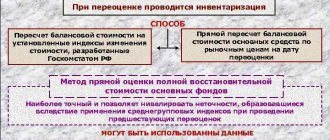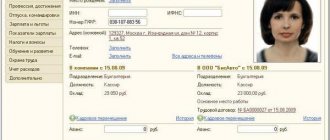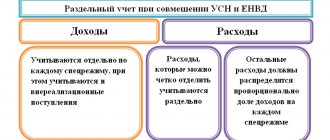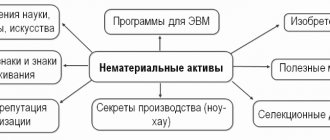Organization of tax accounting
The basic requirements for tax accounting of depreciable property are given in Article 323 of the Tax Code of the Russian Federation. Accounting for income and expenses on depreciable property is carried out object by object. The exception is depreciation when using the non-linear method.
The tax accounting system developed in the organization must contain information:
- about the initial cost of the property;
- about the useful life;
- on the date of acquisition and commissioning;
- on depreciation of fixed assets (intangible assets) accrued for the entire period of operation of the facilities - using the straight-line method of calculating depreciation;
- about depreciation and the total balance of each depreciation group (subgroup) - with a non-linear method of calculating depreciation;
- on the residual value of depreciable property upon its disposal from the depreciation group;
- about sales (date, sales price and sales costs), etc.
A complete list of information that analytical accounting of depreciable property should provide is given in Article 323 of the Tax Code of the Russian Federation.
The Tax Code of the Russian Federation provides for two options for maintaining tax accounting:
- use of accounting registers;
- use of tax accounting registers specially developed by the organization.
This is stated in Article 313 of the Tax Code of the Russian Federation.
Reports for accounting of non-current assets version 2.4
For VNA accounting version 2.4, the ability to prepare reports based on data from accumulation registers has been developed, and reports have also been developed for management accounting.Statement of OS, intangible assets
For VNA accounting version 2.2, the Asset Depreciation Statement has been renamed to the Asset Statement .
For accounting version VNA 2.4:
- reports are generated based on data from accumulation registers;
- added reports Statement of assets, Statement of intangible assets and R&D expenses ;
- reports contain information on management accounting.
Reports can be prepared from the start date of VNA accounting version 2.4. If the report is generated before this date, a corresponding message will be displayed in it. To generate data before this date, you need to use the OS Statement located in the Regulated Accounting section.
The reports include a group of fields in which you can analyze changes in the cost and depreciation of VNA for a period. A decrease or increase in the value and depreciation of capital assets is influenced by certain events, for example, revaluation, depreciation, write-off. Moving the VNA does not affect the completion of these fields.
To obtain data for several accounts at once, use the following report options:
- Statement of fixed assets/intangible assets (accounting)
- Statement of fixed assets/intangible assets (for all accounts)
- Statement of fixed assets/intangible assets (accounting and tax accounting)
- Statement of fixed assets/intangible assets (tax accounting)
- Statement of fixed assets/intangible assets (management accounting)
OS inventory book
The structure and format of the report have not changed, but now it contains data from regulated accounting and accumulation registers. Thus, the report includes the ability to obtain data for a period that contains information before and after the transition to VNA accounting version 2.4. The Asset Inventory Book report displays information about asset revaluations.
Help - calculation of depreciation of fixed assets, intangible assets
For VNA accounting version 2.4, a new report has been developed , Help-calculation of depreciation of fixed assets, intangible assets , the operation algorithm and form of which differ from the similar report for VNA accounting version 2.2.
This report allows you to analyze how depreciation is calculated and is used to control the calculation.
The report can be generated:
- from the OS/IMA card:
- from the reports panel;
- from the document form Depreciation of fixed assets/intangible assets.
The report reflects the amount of depreciation that has already been calculated at the end of the month, i.e. if the month was not closed, the report will be empty (in the report for the VNA accounting version 2.2, depreciation is calculated when generating the report).
Calculation parameters are used from information registers at the time of report preparation. In particular, the parameters for calculating depreciation in management accounting are used from the Depreciation of fixed assets/intangible assets , which are saved at the time of calculating depreciation.
After upgrading to the new version, existing register entries will not contain parameters and the fields in the report will be empty. A warning about this will appear in the report. In order for the fields to be filled in, depreciation must be recalculated.
For each depreciation calculation method, its own report header and depreciation calculation formula are displayed in the form [1] / [2] * [3], where [1, 2, 3] are column numbers.
If the depreciation calculation is not relevant for the selected period, the report displays a message warning about the need to close the month.
From the Fixed Assets , you can open a contextual report.
Changes have been made to the following metadata: details have been added to the Depreciation of fixed assets/intangible assets that contain parameters for calculating depreciation:
- used in the current month;
- number of months passed or operating time for past months;
- cost for calculating depreciation;
- term of use;
- a sign of additional accrual for the previous month.
There is no automatic update.
Help - calculation of depreciation bonus
The structure and format of the report have not changed, but now it is filled out according to accounting data and accumulation registers. Thus, the report provides the ability to obtain information for a period that includes data before and after the transition to VNA accounting version 2.4.
Tax registers
If the selected rules for accounting for depreciable property in accounting and tax accounting coincide, then the organization can generate tax accounting data based on accounting registers (paragraph 3 of Article 313 of the Tax Code of the Russian Federation). It is not necessary to maintain separate tax registers. This situation is explained by a number of reasons. Firstly, information for tax accounting is taken from the same primary documents that are used to reflect transactions in accounting. Secondly, due to the overlap of many methods and methods of assessment in tax and accounting, it is impractical to compile separate tax registers. To calculate the tax base, you can use accounting data.
Thus, if there are no differences between accounting and tax accounting, do not maintain tax registers. And in the accounting policy for tax purposes, specify the sources from which the data for calculating the tax base is taken (list of accounting registers).
If the selected rules for accounting for depreciable property in accounting and tax accounting do not coincide, then the organization must generate tax accounting data for fixed assets separately from accounting. You can do this in two ways:
- supplementing the accounting registers with the necessary details so that they can be used in tax accounting;
- create separate tax accounting registers.
If an organization decides to develop tax registers, then it must be borne in mind that there are no mandatory forms (forms) for such registers in the legislation. The organization itself decides which registers to use in its activities (Article 314 of the Tax Code of the Russian Federation).
Tax accounting registers developed by an organization must contain a number of mandatory details:
- register name;
- period (date) of compilation;
- meters of transactions in kind (if possible) and in monetary terms;
- name of business transactions;
- signature (deciphering the signature) of the employee responsible for compiling these registers.
These are the requirements of Article 313 of the Tax Code of the Russian Federation.
In addition to the required details, include in the register those details that will help you correctly calculate the amount of depreciation charges. They may be:
- sizes of increasing or decreasing coefficients;
- method of calculating depreciation;
- useful life;
- residual value.
In any case, in the accounting policy for tax purposes, indicate the composition of tax registers (either in the form of a list, if they are among those recommended by inspectors, or in the form of an appendix (album of forms)). In addition, identify other data sources for tax accounting, if they are used (accounting registers, analytical accounting data, etc.). These are the requirements of Article 314 of the Tax Code of the Russian Federation.
The Tax Service has developed recommended sample tax register forms. They are given in the recommendations of the Ministry of Taxes of Russia dated December 19, 2001. It is not necessary to use these forms, but they can serve as an example for registers developed by the organization.
Attention: during an on-site inspection, inspectors have the right to request from the organization tax registers confirming the calculation of the tax base (clause 1 of Article 93 of the Tax Code of the Russian Federation). For failure to submit these documents within 10 working days from the date of receipt of the written request, tax and administrative liability is provided (Clause 3 of Article 93, Article 120 of the Tax Code of the Russian Federation, Part 1 of Article 15.6 of the Code of Administrative Offenses of the Russian Federation).
The absence of tax registers is recognized as a gross violation of the rules for accounting for income and expenses. Responsibility for it is provided for in Article 120 of the Tax Code of the Russian Federation.
If such a violation was committed during one tax period, the inspectorate has the right to fine the organization in the amount of 10,000 rubles. If a violation is detected in different tax periods, the fine will increase to RUB 30,000.
A violation that led to an understatement of the tax base will entail a fine of 20 percent of the amount of each unpaid tax, but not less than RUB 40,000.
In addition, for failure to submit tax registers at the request of the tax inspectorate, the court may impose administrative liability on officials of the organization (for example, its head) in the form of a fine in the amount of 300 to 500 rubles. (Part 1 of Article 23.1, Part 1 of Article 15.6 of the Code of Administrative Offenses of the Russian Federation). Tax liability for similar violations is established by Article 126 of the Tax Code of the Russian Federation. However, paragraph 1 of Article 126 of the Tax Code of the Russian Federation provides for the accrual of a fine for each unsubmitted document. Since the organization determines the number and form of tax accounting registers independently (Article 313 of the Tax Code of the Russian Federation), it is impossible to determine in advance how many registers should be submitted to the inspectorate. Consequently, the amount of the fine in the situation under consideration cannot be determined. Some arbitration courts confirm this conclusion (see, for example, the resolution of the Federal Antimonopoly Service of the North-Western District dated February 2, 2004 No. A13-6442/03-21).
If the organization is unable to submit the required documents within 10 working days from the date of receipt of the request, this period can be extended.
Accounting for OS receipt in 1C
When purchasing new equipment, we draw up the “Equipment Receipt” document:
OS and intangible assets -> Receipt of fixed assets -> Receipt of equipment
Fill in the document details:
- Invoice No. – receipt document number
- Counterparty - supplier from the “Counterparties” directory
- Agreement — select an agreement with a supplier (the list contains only those agreements whose type of agreement is “With a supplier”)
- Warehouse - where the equipment will be stored until the OS is put into operation
- Calculations — are filled in automatically according to the program settings, you can verify their correctness by clicking on the hyperlink
- Equipment - filled in from the “Nomenclature” directory
On the “Additional” tab, it is possible to fill in the fields Consignor, Consignee, Invoice for payment
The result of the document is opened for viewing by clicking:
To account 08.04 “Purchase of fixed assets” we received:
- woodworking machine 2 pcs. at a price of 100,000 rubles;
- slipway for assembling doors 2 pcs. at a price of 70,000 rubles.
In addition, accounts payable were formed in the amount of RUB 401,200.
We register the supplier's invoice (only after posting the receipt document, otherwise the invoice will not be posted):
the transaction type code “01” Goods, works, services received”:
Based on the receipt document, you can create a payment document to the supplier. To do this, by clicking “Create based on”, select the document “Payment order”:
In the document form “Payment order” we indicate the payment details.
You must select the Paid and, by clicking on the link, create a document “Write-off from current account“.
When we receive a bank statement, it will be necessary to confirm the fact of debiting funds from the current account in the program and generate transactions. Confirmed by bank statement checkbox in the “Write-off from current account” document
After posting the document, postings will be generated confirming the fact of payment for the received material assets (fixed assets).
Filling registers
Fill out tax accounting registers in chronological order. Tax registers can be maintained in the form of special forms: development tables, statements, journals. Do this on paper (machine) or electronically.
Situation: how to reflect in tax accounting a fixed asset that is fully depreciated (residual value is zero), but which continues to be used?
A fully depreciated fixed asset item is not reflected in tax accounting.
If a fixed asset is fully depreciated, then its cost is fully included in expenses. After the residual value in tax accounting becomes equal to zero, this fixed asset does not participate in the formation of expenses for income tax. Therefore, do not reflect it in tax accounting, since the object of tax accounting is the expenses accepted when calculating income tax (paragraph 4 of Article 313 of the Tax Code of the Russian Federation).
Reflect such an object of fixed assets only in accounting, since control of the availability of assets, including property, is ensured with the help of accounting (Articles 2 and 11 of the Law of December 6, 2011 No. 402-FZ).
An example of compiling a tax register for accounting for expenses for depreciation of fixed assets
On June 2, the organization purchased a computer for 60,000 rubles. On June 15, the main facility was put into operation. The useful life of a computer for accounting and tax accounting is 36 months. Depreciation is calculated using the straight-line method.
According to the accounting policy for tax purposes, when purchasing a fixed asset, the organization writes off 10 percent of its cost as part of depreciation charges. Therefore, depreciation in tax accounting is calculated from the original cost reduced by the amount of the depreciation bonus. It is 54,000 rubles. (60,000 rub. – 60,000 rub. × 10%). The organization's accountant took into account the depreciation premium in the month in which depreciation on the computer began to be calculated, that is, in July.
Due to differences in the initial cost of the fixed asset and the use of bonus depreciation, the monthly amount of depreciation in tax and accounting will be different:
- in accounting – 1667 rubles/month. (RUB 60,000: 36 months);
- in tax accounting – 1500 rubles/month. (RUB 54,000: 36 months).
The organization's accountant reflected the depreciation charge on the purchased computer for tax accounting purposes in the depreciation calculation register
Tax accounting of depreciation expenses is not carried out in relation to fixed assets listed in clause 2 of Art. 256 of the Tax Code, as well as fixed assets not used for generating income, i.e. related to the non-banking sector. Tax accounting of depreciation is based mainly on the use of existing accounting registers with the addition of information necessary for tax accounting. Tax registers are maintained on the basis of primary documents used for accounting of fixed assets, i.e. cards for accounting of fixed assets. Data on the depreciation group (Article 258 of the Tax Code) and useful life (determined within the framework of depreciation groups), as well as the depreciation rate for tax accounting purposes, is added to the card for accounting for fixed assets.
Card for accounting of fixed assets - the tax accounting register must contain the following mandatory details:
1.1 Card for accounting of fixed assets (tax register)
| Inventory No. | Name object | Book value | Depreciation. group (clause 2 of article 258) 1-10 | Useful life according to clause 1 of Art. 258 NK, years | Number of years of operation by previous owners | Useful life taking into account the service life of the previous owners or set independently (clause 12 of Article 259) | Special coefficient (clauses 7 and 9 of Article 259) | Depreciation rate for tax purposes, % per year | The amount of accrued depreciation for NU purposes | Date of capitalization of fixed assets in accounting | Useful life expiration date |
– inventory number according to accounting data; – name of the object according to accounting data; – book value according to accounting data; – depreciation group (clause 2 of Article 258) for an object is determined on the basis of Decree of the Government of the Russian Federation of January 1, 2002 No. 1 “On the Classification of fixed assets included in depreciation groups” – useful life of the object (clause 1 of Article 258 ) ; – the service life of the previous owners is determined based on the acquired previously operated objects. The service life of the previous owners is determined by the purchasing departments based on the year of manufacture, commissioning of constructed facilities, etc. – The useful life, taking into account the service life of the previous owners (clause 12 of Article 259), is determined as the difference between columns () and () or is established independently if such a life is greater than or equal to the useful life established in accordance with the Tax Code; – special coefficients are determined on the basis of clauses 7 and 9 of Art. 259 Tax Code (conditions of an aggressive environment and increased shifts, leased property, cars and minibuses); – the depreciation rate is determined by the formula 1/()**100% or 1/()**100% – for objects previously operated by other owners; – determined on a monthly accrual basis according to depreciation rates for tax purposes ()*()/12. As of 01.01.02, the amount of depreciation for tax purposes is determined taking into account the transitional provisions of Federal Law No. 110-FZ; (Tax base of the transition period) – accounting data; – is defined as the sum of () and () or () and () – for objects previously operated by other owners.
The main differences in the calculation of depreciation amounts for tax accounting of depreciable property from accounting of fixed assets
| Groups and types of fixed assets | Depreciation calculation | |
| Accounting | Tax accounting Tax Code of the Russian Federation (part two) dated 05.08. 2000 No. 117-FZ, chapter 25, article 256, clause 2 | |
| Housing facilities | not credited | accrued |
| Perennial plantings that have not reached operational age | not credited | accrued |
| Fixed assets acquired using budgetary allocations and other similar funds (in terms of the cost attributable to the amount of these funds) | accrued | not credited |
| Fixed assets transferred (received) under contracts for free use | accrued | not credited |
| Fixed assets of non-profit organizations not used for business activities | not credited | accrued |
AISS BKB, www.orioncom.ru, tel (495) 783-5510
Error correction
If an error is found in the tax accounting register, only the employee responsible for maintaining the register has the right to make a correction. Moreover, the correction must not only be certified by the signature of the latter (indicating the date), but also justified in writing.
This procedure is provided for in Article 314 of the Tax Code of the Russian Federation.
The Tax Code of the Russian Federation does not specify how to make corrections to the tax register. Therefore, this can be done, for example, by including a correction entry (if the register is generated electronically) or by crossing out the incorrect amount (if the register is compiled on paper).






